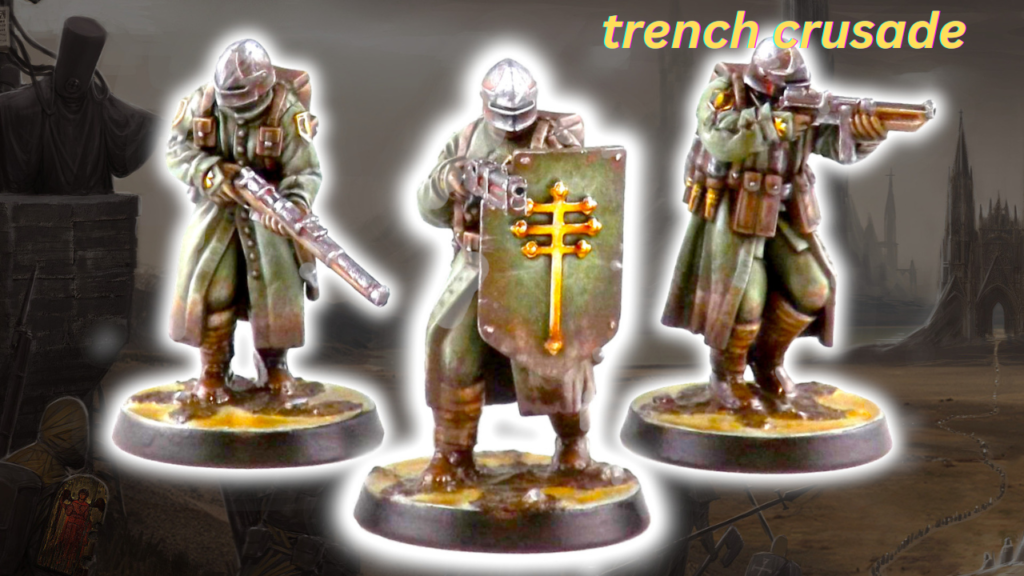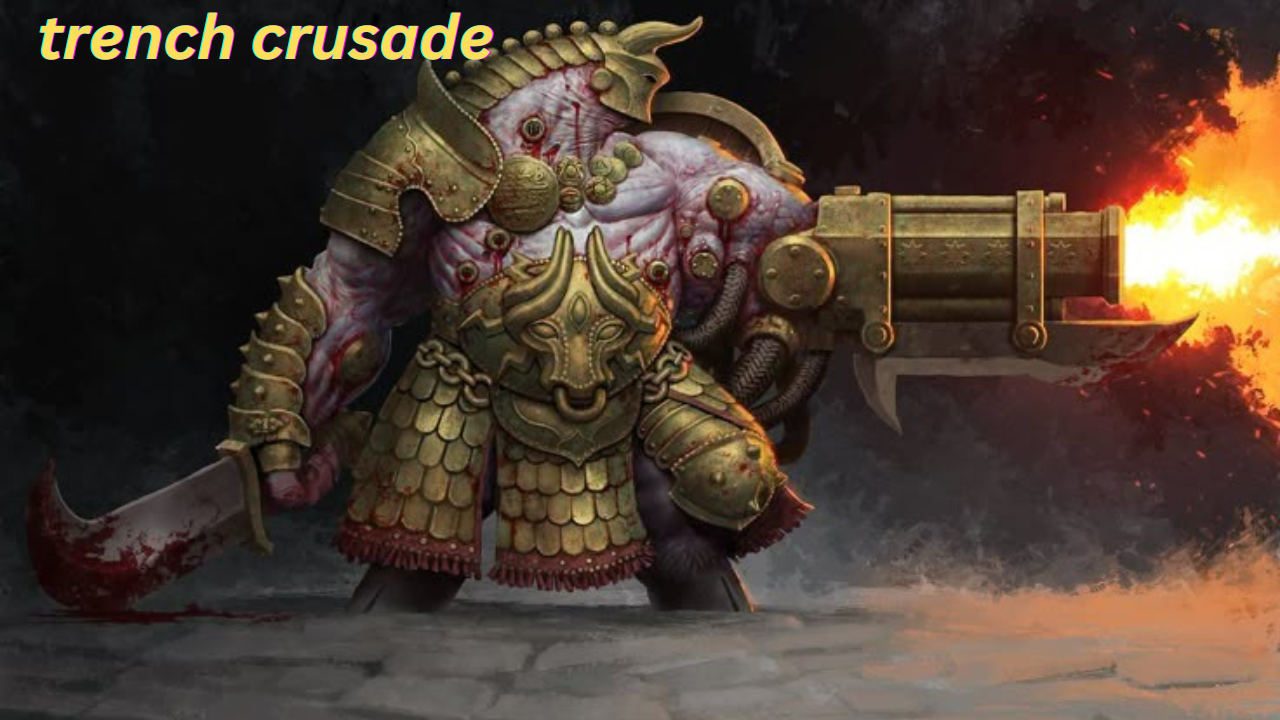Trench Crusade The Unsung Heroes of History s Fiercest Conflicts
Trench warfare is one of the most brutal and enduring strategies in the history of military combat. It became a defining characteristic of World War I and marked a significant shift in the way wars were fought. The term “Trench Crusade” evokes a powerful image of soldiers entrenched in the earth, battling not just the enemy, but the harsh conditions of warfare. The trenches were not only physical barriers but symbols of a prolonged struggle where both mental and physical endurance were tested to their limits. This article delves deep into the origins, evolution, and lasting impact of trench warfare, exploring how these strategies shaped the course of history and left an indelible mark on the soldiers who fought in them.
The Origins of Trench Warfare
Early Beginnings of Trench Combat
Trench warfare did not suddenly emerge in the early 20th century. Its origins can be traced back to earlier conflicts, where soldiers dug into the earth for protection against the threat of advancing enemy forces. The concept of entrenched defense became particularly noticeable during the American Civil War, where both Union and Confederate forces relied on trenches to hold strategic positions. Similarly, during the Boer War at the turn of the century, trench warfare gained more prominence as a defensive tactic.
However, it was during World War I that trench warfare truly came to the forefront as a dominant strategy. The battlefronts of Western Europe, particularly along the French and Belgian borders, were defined by miles of trenches stretching from the North Sea to Switzerland. These defensive networks were a direct response to the advancements in firearms and artillery, which made open-field warfare increasingly deadly. With machine guns and long-range artillery becoming more accurate and lethal, soldiers found themselves trapped in trenches as they sought refuge from the onslaught of enemy fire.
Technological Advancements
The need for trenches in combat was not only driven by the lethality of weapons but also by the technological advancements that characterized the early 20th century. Innovations in weaponry, such as the machine gun, heavy artillery, and poison gas, made traditional warfare tactics obsolete. These weapons had the power to wipe out entire battalions, forcing soldiers to find shelter in trenches to minimize their exposure to these devastating technologies.
In addition to weaponry, the rise of industrialization played a key role in the evolution of trench warfare. Advances in transportation, communication, and logistics allowed armies to mobilize on a larger scale, and the creation of extensive trench networks was necessary to sustain these larger forces. As soldiers dug into the earth, the trenches became not only places of defense but also homes, where men spent months and even years enduring the hardships of war.
The Role of Trench Warfare in World War I
Trench Warfare as a Defensive Strategy
The Western Front during World War I became the epitome of trench warfare, with soldiers fighting not for territory but for survival. The battle lines stretched for hundreds of miles, and the opposing forces were often separated by just a few hundred yards. The trenches themselves were complex systems, with multiple layers designed to withstand artillery bombardments and provide defense against enemy incursions. Soldiers spent days and nights on the front lines, fighting to maintain their positions against overwhelming odds.
Life in the trenches was grueling. The constant bombardment of artillery shells created a landscape of devastation, while soldiers lived in cramped, unsanitary conditions. Diseases such as trench foot, dysentery, and typhoid fever spread quickly among the troops, exacerbating the already dire situation. Despite these hardships, soldiers continued to hold their positions, often launching small, limited attacks known as “raids” in a desperate attempt to gain ground.
Key battles such as the Battle of the Somme and Verdun became synonymous with the horrors of trench warfare. These battles resulted in massive casualties on both sides, with little to show in terms of territorial gains. The “no man’s land” between the trenches became a symbol of the futility and horror of war, where thousands of soldiers were killed or wounded in a matter of hours.
Psychological and Physical Effects on Soldiers
The impact of trench warfare on soldiers went far beyond physical injuries. The constant stress of battle, the sight of death, and the ever-present danger of being killed or maimed left lasting psychological scars on many soldiers. “Shell shock,” now recognized as a form of post-traumatic stress disorder (PTSD), became widespread among troops. The psychological toll of living in trenches for months at a time, coupled with the trauma of witnessing the brutality of war, contributed to the mental breakdowns of countless soldiers.
Physically, the conditions in the trenches were equally devastating. Soldiers lived in squalid, overcrowded spaces with little access to fresh food or water. The trenches were filled with mud, rats, and lice, and the constant exposure to rain and cold led to numerous cases of trench foot and frostbite. The constant noise of artillery bombardments, coupled with the threat of poison gas attacks, created an environment of near-constant fear and anxiety.
Despite these conditions, soldiers exhibited remarkable resilience. Many soldiers found ways to cope with the horrors of trench warfare, forming close bonds with their comrades and finding moments of levity in an otherwise bleak existence. The trenches may have been a place of death and despair, but they also became a symbol of endurance and camaraderie.
The Evolution of Trench Warfare in Subsequent Conflicts

Trench Warfare in World War II and Beyond
While trench warfare largely faded after World War I, its influence persisted in subsequent conflicts. World War II, for example, saw the use of fortified defensive positions, though more advanced technology such as tanks, aircraft, and mobile artillery made traditional trench warfare less viable. Nevertheless, elements of trench warfare could still be seen in the form of defensive lines, such as the Maginot Line in France, where entrenched fortifications were used to resist enemy invasion.
In the years following WWII, trench warfare largely became obsolete with the rise of more mobile warfare strategies. The use of mechanized infantry and air superiority meant that armies could advance and retreat quickly, rendering static trench warfare ineffective. However, the principles of defense and fortification continued to play a role in modern warfare, especially in cases of guerrilla warfare, where combatants often rely on dug-in positions and defensive tactics.
Modern-Day Relevance and Usage
Though traditional trench warfare is rarely used in modern conflicts, its legacy can still be seen in certain regions of the world. In areas with ongoing conflicts, such as the Middle East, soldiers often dig trenches to protect themselves from enemy fire and to create defensive positions. The lessons learned from trench warfare—such as the importance of fortification and defense—continue to inform military strategies today, particularly in asymmetric warfare.
The modern understanding of trench warfare emphasizes the need for adaptive tactics and quick response times. The static, prolonged battles of World War I have largely been replaced by more dynamic forms of conflict, but the principles of trench combat still influence modern military strategies.
The Trench Crusade: Heroes and Stories from the Trenches
Profiles of Trench Crusaders
The soldiers who fought in the trenches during World War I are often remembered for their courage, endurance, and sacrifice. Many soldiers became legends for their actions on the battlefield. One such example is Sergeant York, an American soldier who became a hero for his bravery during the Battle of the Argonne. His actions, which included single-handedly capturing a German machine gun nest, earned him the Medal of Honor and immortalized him in American military history.
Similarly, British soldiers such as Lieutenant Colonel Wilfrid Spencer and Captain Billy Bishop became well-known for their leadership and bravery in the trenches. These men, along with countless others, are often remembered as the unsung heroes of the “trench crusade,” fighting not just for their country, but for the survival of their comrades.
Legacy of Trench Warfare
The legacy of trench warfare goes beyond the battlefield. It has shaped how modern soldiers are trained and how military leaders approach defense strategies. The trench networks of World War I remain a testament to the sacrifices made by soldiers and the horrors they endured. Many of these trenches have been preserved as memorials and museums, serving as a reminder of the sacrifices made during the “Great War.”
The “Trench Crusade” is not just a military event but a cultural one. The imagery of soldiers fighting from the safety of the trenches has become a powerful symbol of courage, resilience, and the human spirit’s ability to endure in the face of overwhelming adversity.
Conclusion
Trench warfare, particularly during World War I, stands as one of the most defining aspects of military history. The hardships faced by soldiers in the trenches shaped not only the course of the war but also the future of warfare itself. From the technological advancements that led to the development of trench warfare to the enduring legacy of the men who fought in the trenches, the “Trench Crusade” serves as a reminder of the sacrifices and suffering endured by countless soldiers in the name of defense and honor.
FAQs
What exactly is trench warfare?
Trench warfare is a type of combat in which soldiers fight from within deep trenches to protect themselves from enemy fire. This style of warfare became common during World War I.
How did trench warfare change the tactics used in World War I?
Trench warfare led to the development of defensive strategies, where both sides dug extensive trench systems to protect themselves from new technologies like machine guns and artillery.A
What were the main challenges soldiers faced in the trenches?
Soldiers in the trenches faced harsh conditions such as constant bombardment, diseases, rats, lack of food, and psychological stress due to the prolonged nature of trench warfare.
Was trench warfare used in other wars besides World War I?
While trench warfare was most prominent during World War I, elements of it were seen in other conflicts, such as the American Civil War, the Boer War, and even modern-day guerrilla warfare.
How did trench warfare impact the mental health of soldiers?
The extreme conditions of trench warfare led to widespread psychological issues, including shell shock (now recognized as PTSD), affecting many soldiers long after they left the front lines.
You May Also Read: https://networkinfonews.com/octordle-hint/














Post Comment